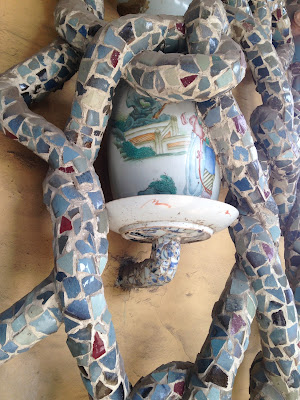Porcelain House, also known as China house, is a contemporary museum of pottery and antiques in Tianjin. The museum is located in a historical colonial building, which has been radically re-decorated by its present owner, Zhang Lianzhi, using copious amounts of broken porcelain.
Trencadís is a type of mosaic used in Catalan modernism, created from broken tile shards. The technique is also called pique assiette. This mosaic is done using broken pieces of ceramic, like tiles and dinnerware. This form of art is believed to have been originally introduced by Raymond Edouard Isadore, known as the "father of French pique assiette". He discovered his bits of colored glass and pottery in the fields surrounding his house in Chartres, outside of Paris, and spent his life covering every surface of the inside and outside of the house and his garden area. He supplemented his shards with stuff from auctions, quarries and the public dump. His home is a popular tourist attraction and is known as "Maison Picassiette". The Catalan architects Antoni Gaudí and Josep Maria Jujol used trencadís in many projects, among which Barcelona's Parc Güell is probably the most famous.
Modernist architects made extensive use of ceramics, but Antoni Gaudí in particular proposed a more unconventional method. He covered his three-dimensional architecture with glazed ceramics of different shapes and colours, which created brightly coloured patterns. For the task, he used discarded pieces of ceramic tiles collected from the factory "Pujol i Bausis" located in Esplugues de Llobregat, and pieces of white ceramic from broken cups and plates discarded by other Spanish manufacturers.
The technique was used for the first time at the Güell Pavilions where the complex architecture forced him to break the tiles where he couldn’t use an entire square one.
Subscribe to:
Post Comments (Atom)










No comments:
Post a Comment